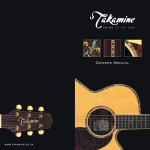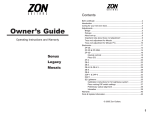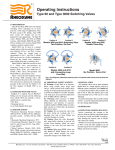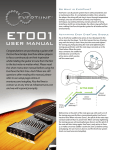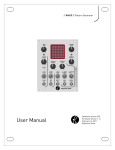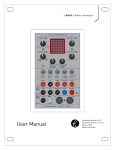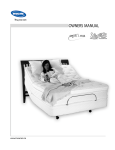Download Saber Bass User Manual
Transcript
LIGHTWAVE SABER BASS OPTICAL PICKUP SYSTEM USER MANUAL LIGHTWAVE SABER BASS OPTICAL PICKUP SYSTEM FOREWORD Thank you and congratulations for your purchase of a LightWave Saber Bass. We would also like to welcome you as a member of the LightWave team. Your Saber Bass couples decades of master luthiery and instrument design with the cutting edge of modern pickup technology - the LightWave Optical Pickup System - LightWave’s exclusive, patented infrared pickup technology. Featuring extraordinary playability and exquisite tone, your Saber Bass is a superb musical instrument that will provide many years of enjoyment and musical performance. Engineered for the rigors of the road, the demands of the modern recording studio, and long, comfortable hours of playing, your Saber Bass is designed to become a direct extension of your creativity. Please follow these simple guidelines for setup and care, and you will enjoy your Saber Bass for years to come. We are always interested in your thoughts about your LightWave Bass and about your music. We encourage you to contact us with your comments and suggestions on how we can continue to serve you in the future. Please visit our website at www.lightwave-systems.com for product update information and other news about LightWave Systems and our growing line of products. TABLE OF CONTENTS 1. DESIGN CONCEPTS…………………………………….. 1 LightWave Optical Pickup System…………………………… The Voice of the String™……………………………………… Long, Natural Sustain …………..…………………………….. Extremely Low Noise………………………….……………..... iceTone™……………………………………...……………….. Tone Shaping……………………………………...…………… 1 1 1 1 2 2 2. QUICK START……………………………………………… 3 3. SETUP………………………………………………………… 4 3.1 Neck and Action Adjustments……………………………. 3.2 Saddle Adjustment………………………………………… 3.3 Intonation…………………………………………………... 3.4 Optics Alignment……………..……………………………. 4 4 5 5 4. POWER AND CONTROLS..……………………………. 7 4.1 Control Elements………………………………………….. 7 4.2 Battery Pack Advisory…………………………………….. 8 4.3 Instrument Maintenance……………………………......... 9 5. MAG HYBRID EDITION………………………………… 9 6. HEX FX EDITION…………………………………………. 10 7. APPENDICES………………………………………………. 12 7.1 Motherboard DIP Switch Settings..……………………… 12 7.2 HexFX Daughterboard DIP Switch Settings…………….12 8. TROUBLESHOOTING…………………………………….. 13 9. WARRANTY…………………………………………………. 14 1. DESIGN CONCEPTS LightWave Optical Pickup System At the core of your Saber Bass is the LightWave Optical Pickup System, a revolutionary new pickup system that uses infrared light technology to faithfully reproduce the true sound of the string. Unlike conventional pickups that interact with string vibration, the LightWave Pickup System ‘sees’ the vibration of the string without affecting the string motion in any way. As a result, the natural sound of the string is transmitted in the most transparent and linear fashion possible. What you hear is an absolutely faithful reproduction of the string vibration. The Voice of the String™ What you will hear is extraordinary: the sound of the strings, the sound of the instrument, and most importantly, the sound of your playing. You will notice a whole new sensitivity in the interaction between your fingers, the strings and the instrument that will create a new palette of subtle nuances and unique tonalities. Playing multi-string chords, close intervals, complex voicings, and harmonics on your Saber Bass will be a revelation. You will hear an openness, transparency and dimensionality unlike anything you have previously experienced. Long, Natural Sustain Since the LightWave Optical Pickup System does not interact with the string, and because it is capable of much greater sensitivity, the strings will sustain much longer. In fact, the strings will sustain for the full duration of their vibration, fading in a pure, linear fashion into silence, without an abrupt ending or distorted artifacts. The decay rate is totally natural, like the pedal sustain of a Grand Piano. Extremely Low Noise Unlike magnetic pickups, which induce extraneous noise to the sound, the LightWave Optical Pickup has virtually no self-noise. As a result, you can play at any volume without annoying background hum or buzz. This is an absolute breakthrough for modern recording: noise-free, extraordinarily transparent sound. Even with your amp at high volume, you will experience amazing dynamic range and sensitivity. 1 iceTone™ This control allows the blending of the tailored piezo transducers built into each individual string saddle. iceTone is a patented LightWave Systems piezo design that was specifically developed to avoid the clack and harshness typical of piezos while integrating seamlessly with the LightWave Optical Pickup. The result is a smooth, natural sounding high frequency enhancement ranging from crisp high end to percussive presence. iceTone cannot be selected separately, but is added to the optical signal as the control knob is turned up. Tone Shaping If you wish to use EQ to shape your sound, you can use any amount desired to create subtle or dramatic tonal variations without tonal artifacts. Since the output of the LightWave Optical Pickup is pure and transparent, you will be augmenting the sound of the string alone, as opposed to the inherent response curves and background noise found in conventional pickups. 2 2. QUICK START 3 • The Saber Bass electronics are powered by a rechargeable NiMH Battery Pack (see section 4.2 Battery Pack Advisory). The battery pack must have at least a partial charge to begin playing. The Saber Bass will play for approximately 15 hours on a full charge. • The red Status LED on the top of the low string monolith acts as a power-on indicator, and as a fuel gauge for the battery charge. When the LED is well lit, it indicates that there is a sufficient charge to play the instrument. As the battery reaches the lower end of its charge capacity, the Status LED will dim, and when it goes out completely, you have reached the reserve charge, which lasts about another two hours of play time. • In the event that the instrument has not been charged sufficiently prior to playing, or has run down before the end of a session, the instrument can be played directly from the charger unit with no sonic or noise penalty. • The 1/4” Output Jack also functions as an on / off switch, so begin by connecting the instrument to an amplifier using a conventional guitar cable. • If the amplifier features a choice of Active or Passive inputs, use the Active input. • The Saber Bass has unique sonic characteristics, so it is suggested that you begin with all of the instrument controls in the flat (center detent) position. You can then experiment with the many combinations possible, and the interaction between you the player, the instrument, and your amplifier rig. The Saber Bass is compatible with all typical bass preamp, amplifier, and signal processing gear. 3. SETUP 3.1 Neck and Action Adjustments Your bass is equipped with a truss rod for neck adjustments. Always perform this adjustment before proceeding to set up the playing action and the LightWave Pickup System. If you are unfamiliar with truss rods and instrument setup, please consult a reputable guitar tech. 3.2 Saddle Adjustment Monolith Mounting Screw for Adjusting Intonation (one of two 3mm hex) Hex Adjustment Screw for Adjusting Optics (5/64” hex) String Saddle Height Adjustment Screw (.050” hex) Monolith Mounting Screw for Adjusting Intonation (one of two 3mm hex) Closeup Showing Monolith Detail Each string has a saddle height adjustment screw, located in the string saddle in the monolithic bridge assembly. Turning the screw clockwise raises the saddle; turning counterclockwise lowers it. Use a .050” hex driver for adjustment. The action can be adjusted while the strings are under tension. Adjusting the saddle height or changing string gauges typically requires realigning the optics (see 3.4 Optics Alignment). Exchanging a fresh set of identical strings (the same gauge and brand) should not require realigning the optics. 4 3.3 Intonation Intonation will likely be with the highest pitch string being closest to the nominal scale length, and each string diameter larger being slightly more set back towards the tail end of the instrument. Strings that are articulated, or have exposed cores, will intonate closer to the actual scale length. To adjust the intonation: • Remove tension from the selected string. • With the 3mm hex driver, loosen the two monolith mounting screws. • Reposition the monolith in the new desired intonation location. • Re-tighten the monolith mounting screws to the deck of the instrument. • Bring the string back to pitch, and check intonation. Repeat as needed to achieve desired intonation accuracy. 3.4 Optics Alignment String Setup Selector (Rotary Switch) Optical Level Trimpots “SL1” through “SL6” Optics Setup LED (Red/Green) Motherboard Closeup Showing Setup Detail 5 The following setup procedure is performed in order to align the centerline of the optics with the long axis of the string. This will provide maximum output, as well as accommodate string bending and related playing techniques. This operation can be done by ear, or electronically. In either case, turn on the bass, and adjust the position of the optics by turning the 5/64” hex adjustment screw on top of each monolith. By ear, with the instrument plugged into an amplifier and/or headphones: raise and lower the optics, listening for the “sweet spot”, where the sound output is loudest. Electronically: select the string to be calibrated, by turning the miniature rotary selector switch on the Motherboard (use a ~2mm flat screwdriver). If your bass has the HexFX option, the rotary switch will be hidden under the HexFX daughterboard. Lift straight up on the daughterboard to temporarily move it out of the way. The switch positions are numbered to correspond with the strings, with position 1 being the highest frequency string. When the string is selected, the red/green LED on the Motherboard indicates the position of the optics. LED ‘green’ indicates that the optics are below the string, and must be raised (clockwise turn of the adjustment screw). LED ‘red’ indicates that the optics are above the string, and must be lowered (counterclockwise turn of the adjustment screw). At the optimum adjustment point, the LED will extinguish, indicating that the optics are centered. Take care not to turn the adjustment screw too far in either direction, and do not force it. After all of the strings have been calibrated, turn the rotary switch back to the zero position. After proper optics setup, the output of each string can be adjusted for overall balance using the corresponding trimpots on the Motherboard. These are the six miniature trimpots in a row, at the center of the Motherboard, labeled ‘SL1’ through ‘SL6’. ‘SL1’ designates the highest pitch string. Full output is at the end of the clockwise rotation of the trimpot, and is recommended for optimum performance. Start with all strings at the full up position, and balance the outputs by attenuating, or turning down, the louder strings until outputs are equal. The trimpot adjustment range is 10db. The trimpots for any unused string channels have no effect on signal level, and should be turned fully down (counterclockwise). 6 4. POWER AND CONTROLS Master Volume Bass Boost / Cut Mids Boost / Cut Mids Frequency Warm / Cool Switch (Towards Neck: Warm Towards Bridge: Cool) iceTone™ Level Standard (Optical/iceTone™) Edition 4.1 Control Elements 7 • Master Volume: Makes the overall signal (optics plus iceTone) louder or softer. Full rotation clockwise results in an output level comparable to most existing active basses. • Bass Boost and Cut: Shelving Type. • Mids Boost and Cut: +/-12dB, at frequency selected by the mids sweep control. Q varies (see below). • Mids Center Frequency (Sweep): 200 Hz (counterclockwise) to 1 kHz (clockwise). Provides a varying Q, that is narrow in the low frequencies and increasingly broad in the higher frequencies, for a more useful effect range. • iceTone™: The iceTone control blends in the high frequency enhancement built into each individual string saddle. iceTone cannot be selected separately, but is added to the optical signal. Blending in some iceTone will deliver more percussive presence and crisp high end. Full rotation counterclockwise is off. +/-12dB with knee at ~300 Hz. • Warm / Cool Switch: This miniature toggle switch provides a switched-in EQ that applies an upward-tilted frequency response curve, to produce a leaner, cooler balance, with less bass and more upper mids. The two positions of the switch are similar to selecting the neck or bridge pickups of a conventional bass guitar with two magnetic pickups. The Warm / Cool Switch does not appear on LightWave basses with the Mag Hybrid option. • Output Jack: Plugging in a standard 1/4” cable powers the LightWave Optical Pickup System. This turns the pickup system on, for normal playing, for optical setup, or for use of the 13-pin HexFX output. The cable should be unplugged when the instrument is not in use to conserve power and to avoid unnecessary battery drain. • Charger Jack: Insert the LightWave wall charger into this 1/8” jack to recharge the internal NiMH battery pack, or to play using AC power. The rapid charge system will fully recharge the battery pack in about an hour, even while playing. Playtime on a fully charged battery is about 15 hours. (See Battery Pack Advisory 4.2 below). • Status LED: The red LED, located on the low string monolith, illuminates when a 1/4” plug is inserted into the output jack. The LED brightness dims as the battery pack charge is used, acting as a fuel gauge. When the LED goes out, you are playing on ‘reserve’, and should plug in the charger within an hour or two. 4.2 Battery Pack Advisory The LightWave System uses a NiMH battery pack. The battery pack will have a partial charge when you receive it. All NiMH batteries require several cycles of complete charge / discharge to restore full capacity after storage. To be assured of a full-capacity charge and optimal playing time, follow these steps: • • • 8 Plug in the Battery Charger, to charge the battery completely (approximately 1 hour or less). Unplug the Charger Plug a cable into the 1/4” Output Jack, and leave the instrument on for at least 16 hours to discharge the battery pack completely • • Repeat several times. This will condition the battery to reach full capacity. This conditioning should be done a couple of times a year, or when the instrument play time seems to be diminishing, or if the instrument has been unused for a long duration. The playing time on a full capacity, fully charged battery is about 15 hours. The instrument can be played while it is charging. Even a brief charge will extend battery playing time. The battery pack should last for hundreds of charge cycles, and may need to be periodically replaced. This is a custom pack designed for the LightWave Optical Pickup System, and includes protection devices to prevent thermal or electrical overload. Use only authorized LightWave battery packs when a replacement is necessary. 4.3 Instrument Maintenance After you have finished playing, thoroughly wipe the entire instrument, including the strings, with a clean, soft cloth. Avoid exposing the instrument to any chemical or substance that might mar the finish. Avoid prolonged exposure to direct sunlight, or sources of excessive temperature or humidity. 5. MAG HYBRID EDITION Master Volume Bass Boost / Cut Mids Boost / Cut Passive Bypass Mids Frequency Optical / Mag Balance 9 Mag Hybrid Edition LightWave basses with the Magnetic Hybrid option have a conventional magnetic pickup in addition to the LightWave Optical Pickup System. The iceTone piezo transducers have been omitted, so that the fifth deck control knob controls the blend between the magnetic and optical pickup outputs. The knob has a center detent, which represents equal output between the two pickups; rotating to either end will result in only the magnetic or only the optical pickup system sound being heard. In addition, the Warm / Cool toggle switch of standard Saber Basses has been omitted, and replaced with a bypass toggle, to allow direct passive output of the magnetic pickup. The other controls operate as on standard Saber Basses. The Master Volume and Tone Controls affect both the optical and magnetic pickups. 6. HexFX EDITION MIDI Volume Blend Up / Down HexFX Edition Showing Only Added Controls LightWave basses equipped with the HexFX option have a 13-pin DIN output jack and the deck controls to enable playing through and controlling MIDI converters, hex DSP processing devices, and string fanout boxes. The LightWave output signals and deck controls on these instruments are fully compatible with the ‘GK’ standards for existing MIDI-ready guitars and basses. 10 13-Pin Output Jack: This is the standard connection for plugging in a 13-pin cable (not supplied) made by other manufacturers. The LightWave individual string signals, and the single output present at the 1/4” output jack, are routed through the connector pins, in standard configuration. HexFX Volume: This control knob function may differ, depending on the device connected at the far end of the cable; typically it affects the loudness of the MIDI-converted or hex-DSP signals only. The loudness of the instrument’s single output (present at the 1/4” output jack) which is also routed through the 13-pin cable, is still controlled by the Master Volume knob. The signal at the 1/4” jack is present simultaneously with the one routed through the 13-pin cable, and can be used at the same time, or not. If it is not used, a 1/4” cable or dummy plug must be inserted, to power up the LightWave Optical Pickup System. Blend Switch: This three-position toggle switch determines the sound that is output by the device connected at the far end of the 13-pin cable. In the center position, both the instrument output and the output of the device will be heard. In the ‘up’ position, only the instrument output will be heard. In the ‘down’ position, only the output of the connected device will be heard. S1 / S2 Switch: This three-position switch (with spring return-tocenter action) functions as the Up / Down pushbuttons seen on other devices, and its functions may differ depending on the device connected at the far end. LightWave basses omit the ‘power on’ LED seen on some other ‘GK’ style hex pickups, since the LightWave 13-pin output does not rely on getting power from the device connected at the far end. Rather, the LightWave 13-pin output is powered by the same internal battery pack that runs the rest of the pickup system. This LightWave design enables, for example, simple individual string fanout without needing to connect to an active 13-pin device at the far end. 11 7. APPENDICES 7.1 Motherboard DIP Switch Settings On the Motherboard, next to the rotary switch used for the optics setup, there is a four-position DIP switch, labeled SW2. If your bass has the HexFX option, this will be hidden under the HexFX daughterboard. The four slide switches on the unit are labeled ‘1’ through ‘4; their ‘ON’ position is toward the center of the Motherboard. This switch comes set correctly from the factory, and normally does not require any changes. However, if the settings are accidentally changed, note the functions are as follows: Basses with optical and iceTone pickups (Standard models): SW2-1 = iceTone normal (OFF) or full-range (ON) SW2-2 = iceTone gain high (OFF) or low (ON) SW2-3 = Tone Controls Daughterboard in (OFF) or out (ON) SW2-4 = not used (future option) Basses with optical and magnetic pickups (Mag Hybrid Edition): SW2-1 = Mag Pickup high-passed (OFF) or normal (ON) SW2-2 = Mag Pickup gain high (OFF) or low (ON) SW2-3 = Tone Controls Daughterboard in (OFF) or out (ON) SW2-4 = not used (future option) Basses with HexFX option: SW2 has no effect on the individual string 13-pin outputs or controls, but it still affects the single combined signal, as above. 7.2 HexFX Daughterboard DIP Switch Settings On the underside of the HexFX Daughterboard, there is a sixposition DIP switch. The six slide switches on the unit are labeled ‘1’ through ‘6’; their ‘ON’ position is toward the center of the HexFX Daughterboard. This switch comes set correctly from the factory for MIDI converters and hex DSP devices, and normally does not require any changes. However, if the settings are accidentally changed, or if the bass is to be used without a MIDI or DSP device, the functions are as follows: 12 Slide switches 1 thru 6 = individual string outputs conditioned for MIDI converter or hex DSP (OFF), or unconditioned for simple fanout (ON). If the instrument is played through a MIDI converter or hex DSP device, these switches must be in the ‘OFF’ positions, or the connected device will not perform correctly. No damage will result in the wrong position, but the connected device will not perform properly. If the individual string outputs are ‘fanned’ (e.g. to distribute them to different destinations), these switches must be in the ‘ON’ position to hear the normal LightWave pickup sound. No damage will result in the wrong position, but the string outputs through the 13-pin connector will be severely attenuated and lack bass response. Note that none of the deck controls for volume or tone will have any affect on the individual string outputs through the 13-pin connector. The deck controls only affect the single combined signal at the 1/4” output jack and through the dedicated pin in the 13-pin connector. 8. TROUBLESHOOTING Problem: When the guitar cable is plugged in, the Power LED does not light, and no sound is heard. Solution 1: Be sure the cable is a ‘TS’ (Tip / Sleeve) cable, and not a ‘TRS’ (Tip / Ring / Sleeve) cable. Solution 2: Plug in the battery charger unit and try again. Check the back of the bass for the ‘Charge Status’ LED to have lit red. Problem: The sound is very weak and thin. Cause: Insufficient battery voltage. Solution: Check the status of the Power LED to see if it is out, or very dim. If so, the battery pack needs recharging. [You can continue to play with the charger unit plugged in, and the battery pack will still charge.] Problem: The ‘Mids Sweep’ control does not seem to do anything. Solution: Be sure that the ‘Mids Boost / Cut’ control is not in its center (detent) position, which represents no boost or cut, regardless of the position of the ‘Sweep’ control. 13 Problem: One or more strings sound softer than the others. Cause: Optics out of alignment. Solution: Did you just adjust the action or change string gauge? If so, the optical setup may have to be re-done. Check the condition of the optical setup (see 3.4: Optics Alignment). If one or more of the strings is off alignment, re-do the optical setup for all the strings. If not, check the sound of the bass while it is unplugged, and notice whether a suspect string also has low output acoustically. If it does, change that string, or compensate by adjusting the string loudness trimpots (See Motherboard Diagram). Problem: Battery pack charge consumed quickly. Cause: Battery pack capacity reduced because of disuse for an extended period. Solution: Fully charge and discharge the battery pack several times to restore its capacity. (See 4.2 Battery Pack Advisory.) Problem: Battery pack will not charge or hold a charge. Cause 1: Poor connection between battery pack and charger. Solution 1: Make sure the charger unit is plugged firmly into the charger jack, and the battery pack is plugged into the Power Management Board. Cause 2: Battery pack life exceeded. Solution 2: Replace battery pack with a new one. For other problems you may encounter that you cannot resolve or that are not listed here, please contact your Authorized LightWave Systems Retailer where you purchased your Saber Bass, or contact LightWave Systems directly. 9. WARRANTY For basses purchased in the USA, your LightWave US Custom Saber Bass and Optical Pickup Electronics are covered by the LightWave Systems Limited Warranty. Please refer to the Warranty Registration Information included with your bass for detailed information regarding this warranty. To allow us to better serve your needs, please fill out the Warranty Registration Information and send it to us without delay. For warranties outsid the USA, please refer to the LightWave Systems supplier where you purchased your base. Specifications subject to change without notice. 14 LightWave Systems, Inc. 6387-A Rose Lane, Carpinteria, California, 93013 USA Tel: 805.684.3216 Fax: 805.684.6696 www.lightwave-systems.com User Manual Version 1 / Copyright 2005



















